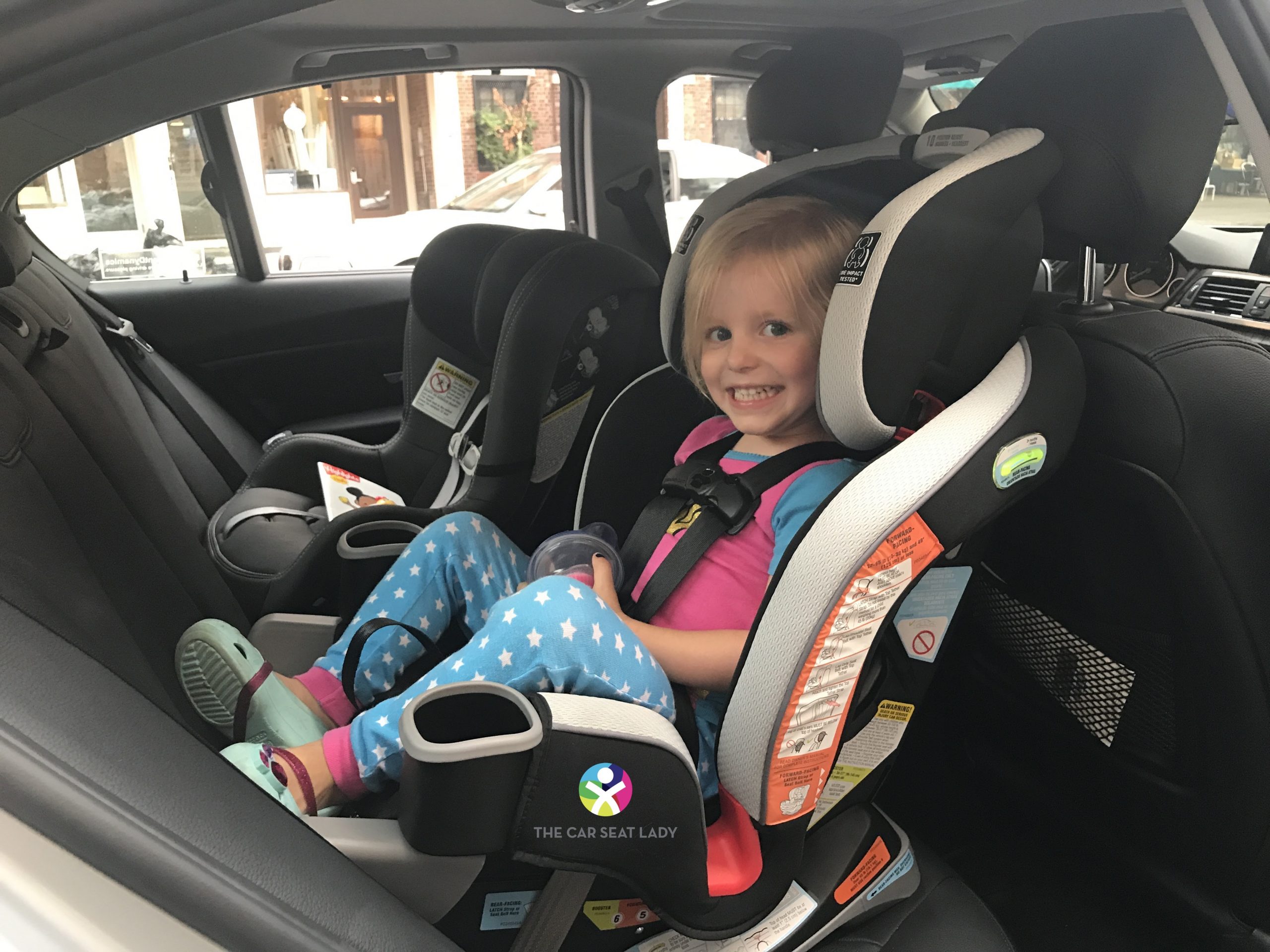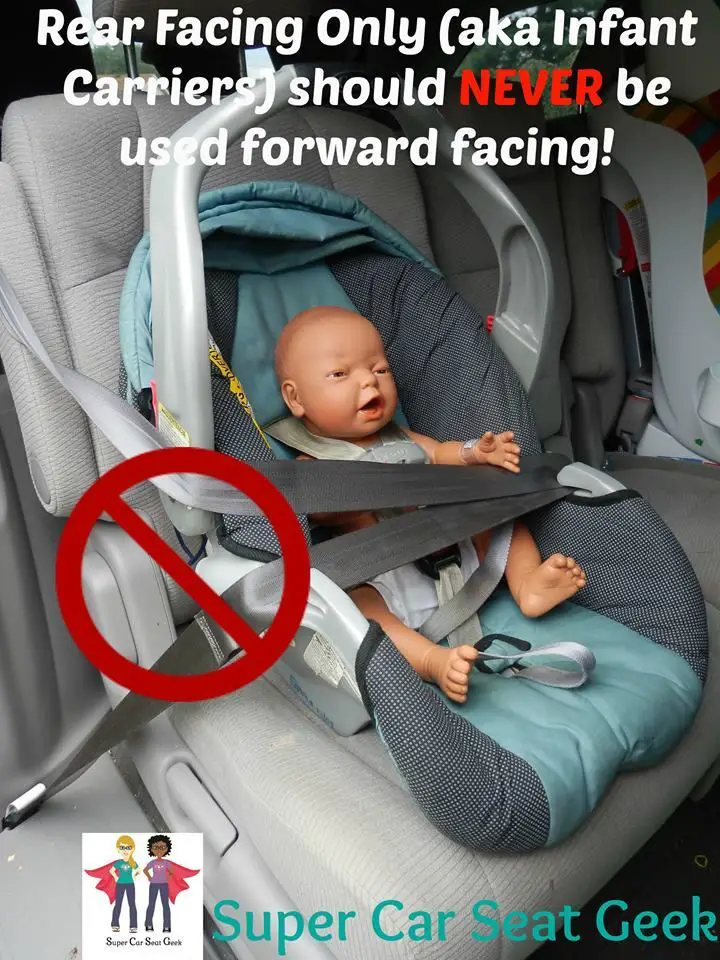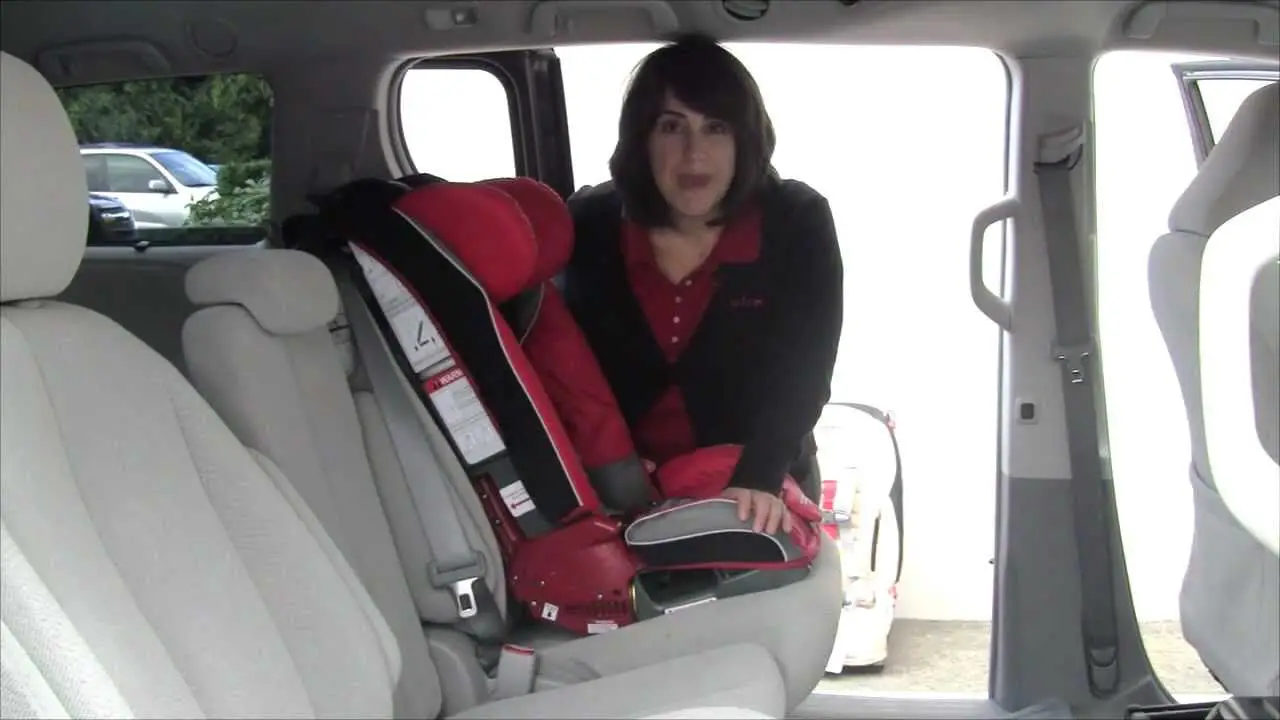Which Is Convertible Car Seat Is The Most Compact Which Is Best For Small Cars
For parents who need to fit three safety seats in the back row, each additional inch of width is crucial. If youre looking for a compact convertible car seat, Cleks Fllo wins hands down, at less than 17, followed by the Britax Marathon ClickTight at 18.5 .
If your vehicle is small in general, go for the Clek Fllo.
Car Safety Tips To Protect Your Child
Here are some car safety tips to make sure your child is protected while travelling in a car:
- Ensure that there is no slack between the car seat and the vehicles seat belt. It should be completely tight and secure.
- Make sure the babys harness straps are pulled tightly. If they are tight enough, you will be able to place just two fingers under the belts.
- Make sure that your babys knees do not push up against the chest. It is all right if the babys feet touch the back of the rear set.
- If you use a rear-facing carrier seat, make sure that it is completely clicked into place.
- Some infants may get fussy in a rear-facing seat. You can add a mirror in the back window that lets them see you. You can also give the baby some car safety-approved toys to play with.
- Do not let the babys head fold forward over her chest. This can cause injuries in case of a crash. Recline the seat far enough so that the head is in a comfortable position.
- Situate the babys car seat in the middle of the vehicles back seat. This is the safest place as doors can get crushed on impact.
- Check the belt path and instructions correctly while installing the car seat.
- Do not bundle your baby in coats or blankets when you place her in a car seat. You can tuck a blanket around the baby once they are strapped in.
What Parents Need To Know
Hoffman toldNBC News that in the last year there has been “significant change in what we know about the relative protection of car seats.” He cited a 2016 Texas legal case in which a car seat manufacturer was found responsible for life-changing injuries of a 20-month-old who was in a front-facing car seat when it did not warn customers of the risks of switching from rear- to front-facing seats.
Ultimately, Hoffman said, the AAP best practice is that parents should delay transitioning children from rear-facing car seats because rear-facing is safer.
The new guidelines say:
- Children should remain in rear-facing seats until they reach the highest weight or height allowed by the seat manufacturer. Find the seat limits in the instruction manual.
- Once children reach the height or weight limit and shift to a forward-facing seat, they should use safety seats with harnesses for as long as possible, often up to 65 pounds.
- When children exceed height or weight limits for those seats, they should use a belt-positioning booster seat until the lap and shoulder belts fit properly, often when the child has reached 4 feet 9 inches in height.
Recommended Reading: How To Clean Dirty Leather Car Seats
Children Between The Ages Of 1 And 4
Colorado car seat law: Children who are older than 1 year old and weigh more than 20 pounds must be properly restrained in a rear-facing or forward-facing car seat.
Safest practice: Children should ride in a rear-facing car safety seat as long as possible, up to the limits of the car safety seat. This will include virtually all children under 2 years old and most children up to 4 years old. Once they have been turned around, children should remain in a forward-facing car safety seat up to that seat’s weight and length limits. Most seats can accommodate children up to 65 pounds.
Restrain your 1- to 4-year-old child in a car safety seat with a five-point harness system, which features two shoulder straps, two hip straps and a crotch strap. A five-point harness system has more places to distribute crash forces and offers better protection than a lap and shoulder belt.
Keep your children in the back seat. Always use the upper-tether strap according to the vehicle owner’s manual and child restraint manufacturer’s instructions.
How Do I Use A Booster Seat

- A booster seat positions your child so that the seat belt fits across the strong bones of the hips and pelvis and not the abdomen, to protect your child from injury.
- While seated in the booster seat, the lap belt should fit low and snug across your childs hips, and not up on their belly.
- The shoulder portion of the seat belt should be positioned over the chest and collarbone, staying between your childs neck and shoulder so that it does not touch the neck.
- Follow the directions for the booster seat to know how to route the seat belt under any armrests or through any belt guides, as directed.
Recommended Reading: How To Remove Scuff Marks From Car Door Panels
Which Are The Best Convertible Car Seats For Airline Travel
The easiest car seat for airline travel would be the Diono Radian 3RXT, since it folds flat. However, another good option which is somewhat safer in general is the Clek Fllo.
Bear in mind that you dont need to buy special car seats for airline travel all you need to do is ensure that the seat you buy is approved for air travel.
If your child is big enough for a booster seat, there are inflatable backless boosters which are safe, lightweight, and convenient.
When Can Your Child Face Forward In A Car Seat
You can make your child sit face forward in a car seat, once they are two years of age or older, and once they have outgrown the height and weight limits of a rear-facing car seat. This is typically at a height of 3 feet and a weight of 13.5 kgs.
Some babies may cry or get cranky in a rear-facing car seat. However, it is in their best interest to remain in a rear-facing seat as this gives them the best chance of survival in case of a car crash.
Also Check: Car Title Transfer Florida
What About Their Legs
Many parents express concern about the fact that their child seems cramped or that their legs must be folded before they have reached the maximum height or weight for their rear-facing seat.
Children can safely sit with their legs crossed, extended, or hanging over the sides of their rear-facing seat. Leg injuries for rear-facing children are very rare, according to the AAP.
Checking The Fit Of The Harness
There are important differences between how to adjust the harness in a rear-facing seat and in a forward-facing seat.
Adjust the harness straps so they are at or just above your child’s shoulders. Some child car seats allow you to adjust the harness height by moving the headrest up or down. You may find this easier to do before you install the child car seat in your vehicle.
As your child grows, check the fit and readjust the harness.
Don’t Miss: How To Get My Vehicle Title
How Long Are Car Seats Good For
Car seats are commonly good for about six years, or roughly the age of which your child wont need a car seat any longer. However, as mentioned above, height and weight are more important metrics in determining how long your child will need a car seat. As such, some manufacturers have adopted longer effective use terms than others.
To make your job as a parent easier, here are a handful of common car seat manufacturers and how long their car seats are good for.
- Graco: 7 to 10 years, depending on car seat selected
- Evenflo: 8 to 10 years, depending on car seat selected
- Recaro: 6 years
Safety.
When To Move Your Child From A Forward
Even if your provincial or territorial regulations allow the use of a booster seat, children should keep using a forward-facing seat until they outgrow its weight or height limits. Many forward-facing seats have weight limits up to 30 kg .
The harness of a forward-facing seat is designed to fit the narrow shoulders of children. This helps protect children in front, side and rear impact crashes. The harness holds your child back and spreads the forces of a crash over the strongest parts of your child’s body.
Don’t Miss: How To Set Up Siriusxm In My Car
What About Off The Charts Big Kids
A 95th percentile child may look stronger than his 5th percentile friend, but in a crash the bigger child is MORE at risk if hes riding forward-facing. The rigidity of bones and the strength of ligaments in the spine is likely the same in children of the same age, no matter their size. And a 95th percentile baby likely has a much larger, heavier head, which will pull forward which much more force than that of a 5th percentile child.
Convertibles with high height and weight limits, enabling rear-facing for as long as possible
What Else Do You Need To Know

In addition:
While each best convertible car seat listed here is rated on Consumer Reports, its not clear if those scores should be a deciding factor.
The reason is this: Consumer Reports writes crash protection and rates each car seat with a score of best,better, or basic but doesnt tell us what those scores mean. The Car Seat Lady said it perfectly when she pointed out that the crash testing was done in a rear-facing positing, forward-facing position, with a seatbelt, with LATCH, etc., but Consumer Reports dont provide us with all the information.
Consumer Reports also doesnt tell us if the dummies that faced forward were simulating children under or above age two.
Why does this information matter, anyways?
Even though infants can technically be placed in a forward-facing seat from about the age of nine months, the American Academy of Pediatrics strongly recommends leaving your child rear-facing *at least* until age two, or until they outgrow their safety seat.
Convertible car seats have an inherent advantage over an infant car seat when it comes to rear-facing children. This is because theyre made to accommodate taller children and are usually able to accommodate heavier children rear-facing longer than a regular infant car seat.
However, Consumer Reports doesnt give us any of the specific info which could help us decide on an appropriate safety seat.
Also Check: Florida Application For Duplicate Title
When Do I Switch My Child To A Forward
You may feel ready to replace your infant or rear-facing car seat with a forward-facing option. While the guidelines may differ from state to state, according to the American Academy of Pediatrics , purchasing a forward-facing seat should be considered when your child has reached the height and weight limits for their rear-facing seat.
Safely Using A Forward
Each forward-facing child safety seat has its own instructions for safe use. Read, follow, and save this information. On newer car seats, this information is printed on the seat.
Follow these general guidelines for safely using a front-facing car seat:
- Look at your cars owner manual for information on using a car seat with your vehicle.
- Secure toddler car seats tightly on the seat using a seatbelt system or the LATCH locking system built into newer cars.
- Both front and rear-facing car seats should be used in the rear seat of the vehicle. Only use a front-facing car seat on the front seat if you have no other choice.
- Do not use any type of car seat in a position with an active airbag.
- Many parents use a front-facing car seat mirror to see their child in the back seat more safely.
- Do not use a damaged or outdated car seat or one you do not know how to use correctly.
- Use a car seat starting with your babys first ride home from the hospital.
Rear and front-facing child car seats save childrens lives. Use one every time you travel with a child.
Products
Also Check: How To Buff Out Scratches On Your Car
How Do I Submit A Claim For A Car Seat
If you have been in a crash and need to submit a claim for a damaged car seat under your comprehensive auto policy, here is what you will need to do :
- Report the accident to your insurance company and state there was a children’s seat damaged.
- Have the brand, year, and type of car seat you are using .
- Purchase a new seat that is around the same cost as the original seat.
- Submit the receipt.
- Frequent use and exposure to sunlight can damage and weaken plastic.
- Spilled drinks, food and cleaners may prevent the webbing, adjusters, and buckles from working safely.
- Second or later owners might not get safety recall notices.
- Harder to determine the history or condition .
When Do Car Seats Expire In Canada
Generally, car seats and booster seats will expire after six to nine years, according to Transport Canada. Always confirm with the manufacturer’s information. You should not use expired car seats because the safety standards have changed, and there are now safer products. Later owners may not get safety recall notices, labels on how to use are faded, and frequent use and exposure can weaken the plastic.
Read Also: How Much Is Car Registration In Texas
Child Car Seats For Infants
Newborn babies and infants need special protection while in a vehicle. In a collision, a properly installed rear-facing child car seat can save your baby’s life.
Ontario’s Highway Traffic Act requires children to use a rear-facing car seat until the child weighs at least 9 kg .
It’s best to keep your child in a rear-facing child car seat until they reach the manufacturer’s recommended maximum weight and height limits. Some rear-facing car seats are made for children that weigh up to 20 kg
When a child outgrows the maximum weight or height limits of an infant rear-facing car seat, they may move to a larger convertible infant/child car seat and stay rear-facing until the child is ready to face forward.
Children Between The Ages Of 8 And 16
Colorado law: Children between the ages of 8 and 16 must use a seat belt or child restraint.
Safest practice: Follow the guidelines above to know when your child can safely stop using the booster. Keep your child in the back seat as long as possible, until at least age 13 and 100 pounds. If your teenager is in the front seat, put the seat as far back as possible in case the airbag deploys in a crash.
Remember that children learn by watching their parents, and this includes good driving habits.
Don’t Miss: What Oil Do I Use For My Car
Riding In The Back Seat Is A Requirement
California car seat law requires that any child under two years old is secured in a rear-facing car seat in the back seat of the vehicle, but older kids also need to sit in the back because its safer than the front seat. Legally, children cant sit in the front seat until they are eight years old, but even then it isnt advisable.
If there is an airbag in the front passenger seat, it is never legal to have a rear-facing car seat in the front seat. The only exceptions when its acceptable for a properly restrained baby or child to ride in the front seat are:
-
There is no back seat in the vehicle, like in a truck or two-seater car.
-
The back seat is fully occupied by younger children.
-
Installing the car seat in the back seat is dangerous, for example, if the back seatbelts are broken.
-
The back seats are rear-facing or side-facing jump seats.
-
There are extenuating circumstances why the backseat cannot be safely used.
When your child is tall enough to safely graduate to wearing a seat belt only its still best for them to steer clear of the front seat. The backseat is always safest for children.
My Child Wants To Be Forward

Even if your child’s legs are touching the seat back, or they cry when rear-facing, you should still keep your child rear-facing until they reach the rear-facing weight or height limit of the car seat. Most convertible car seats have rear-facing weight limits of 35 to 50 pounds, so most kids can ride rear-facing until age three to five. Some children never like sitting in a car seat, and they may cry. However, being properly restrained makes it more likely that a child will survive a crash to cry another day.
Many parents worry that their child will suffer broken legs or hips in a crash because the child’s legs touch the seat back or look cramped when rear-facing. In fact, there are more leg injuries when forward-facing, as the legs fly up and the feet go into the back of the front seat. As everything moves forward, compression forces into the hip and femur can break the leg of the forward-facing child.
Studies of real kids in real crashes shows that leg and hip injuries in rear-facing kids are very uncommon. When they do happen, it is in side impacts where another vehicle hits the child right where their leg is, breaking the leg. Rear-facing kids do not get hip or leg injuries from being scrunched up. In fact, during the instant of the crash, rear-facing kids become even more scrunched, with their legs pulling up into a cannonball position. This is not a cause of injury.
You May Like: Where To Copy Car Key
